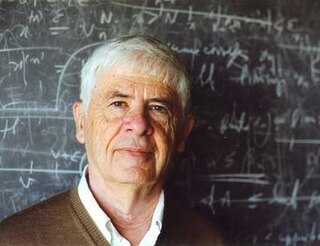
Computational fluid dynamics (CFD) is a branch of fluid mechanics that uses numerical analysis and data structures to analyze and solve problems that involve fluid flows. Computers are used to perform the calculations required to simulate the free-stream flow of the fluid, and the interaction of the fluid with surfaces defined by boundary conditions. With high-speed supercomputers, better solutions can be achieved, and are often required to solve the largest and most complex problems. Ongoing research yields software that improves the accuracy and speed of complex simulation scenarios such as transonic or turbulent flows. Initial validation of such software is typically performed using experimental apparatus such as wind tunnels. In addition, previously performed analytical or empirical analysis of a particular problem can be used for comparison. A final validation is often performed using full-scale testing, such as flight tests.

Gene Howard Golub, was an American numerical analyst who taught at Stanford University as Fletcher Jones Professor of Computer Science and held a courtesy appointment in electrical engineering.

High-resolution schemes are used in the numerical solution of partial differential equations where high accuracy is required in the presence of shocks or discontinuities. They have the following properties:

Alexandre Joel Chorin is an American mathematician known for his contributions to computational fluid mechanics, turbulence, and computational statistical mechanics.

A Riemann solver is a numerical method used to solve a Riemann problem. They are heavily used in computational fluid dynamics and computational magnetohydrodynamics.
Finite element exterior calculus (FEEC) is a mathematical framework that formulates finite element methods using chain complexes. Its main application has been a comprehensive theory for finite element methods in computational electromagnetism, computational solid and fluid mechanics. FEEC was developed in the early 2000s by Douglas N. Arnold, Richard S. Falk and Ragnar Winther, among others. Finite element exterior calculus is sometimes called as an example of a compatible discretization technique, and bears similarities with discrete exterior calculus, although they are distinct theories.
David M. Young Jr. was an American mathematician and computer scientist who was one of the pioneers in the field of modern numerical analysis/scientific computing.

Randall J. LeVeque is a Professor of Applied Mathematics at University of Washington who works in many fields including numerical analysis, computational fluid dynamics, and mathematical theory of conservation laws. Among other contributions, he is lead developer of the open source software project Clawpack for solving hyperbolic partial differential equations using the finite volume method. With Zhilin Li, he has also devised a numerical technique called the immersed interface method for solving problems with elastic boundaries or surface tension.
Burton Wendroff is an American applied mathematician known for his contributions to the development of numerical methods for the solution of hyperbolic partial differential equations. The Lax–Wendroff method for the solution of hyperbolic PDE is named for Wendroff.
The following is a timeline of numerical analysis after 1945, and deals with developments after the invention of the modern electronic computer, which began during Second World War. For a fuller history of the subject before this period, see timeline and history of mathematics.
Thomas Yizhao Hou is the Charles Lee Powell Professor of Applied and Computational Mathematics in the Department of Computing and Mathematical Sciences at the California Institute of Technology. He is known for his work in numerical analysis and mathematical analysis.

Hans Jörg Stetter is a German mathematician, specializing in numerical analysis.
Tang Tao is a Chinese mathematician currently serving as President of BNU-HKBU United International College. Tang is a member of the Chinese Academy of Sciences., Fellow of the European Academy of Sciences., Fellow of the The World Academy of Sciences for the advancement of science in developing countries (TWAS). He is also a fellow of the Society for Industrial and Applied Mathematics and American Mathematical Society.
Weizhu Bao is a Chinese mathematician at the National University of Singapore (NUS). He is known for his work in applied mathematics with applications in quantum physics and chemistry and materials science, especially Bose-Einstein condensation (BEC) and highly oscillatory partial differential equations.
Hongkai Zhao is a Chinese mathematician and Ruth F. DeVarney Distinguished Professor of Mathematics at Duke University. He was formerly the Chancellor's Professor in the Department of Mathematics at the University of California, Irvine. He is known for his work in scientific computing, imaging and numerical analysis, such as the fast sweeping method for Hamilton-Jacobi equation and numerical methods for moving interface problems.
Beresford Neill Parlett is an English applied mathematician, specializing in numerical analysis and scientific computation.

Anders Szepessy is a Swedish mathematician.
Christoph Schwab is a German applied mathematician, specializing in numerical analysis of partial differential equations and boundary integral equations.
Charles Anthony Micchelli is an American mathematician, with an international reputation in numerical analysis, approximation theory, and machine learning.
Charles William Clenshaw was an English mathematician, specializing in numerical analysis. He is known for the Clenshaw algorithm (1955) and Clenshaw–Curtis quadrature (1960). In a 1984 paper Beyond Floating Point, Clenshaw and Frank W. J. Olver introduced symmetric level-index arithmetic.








